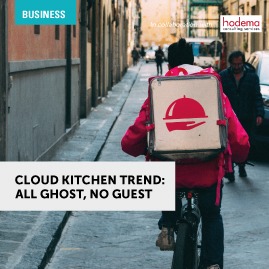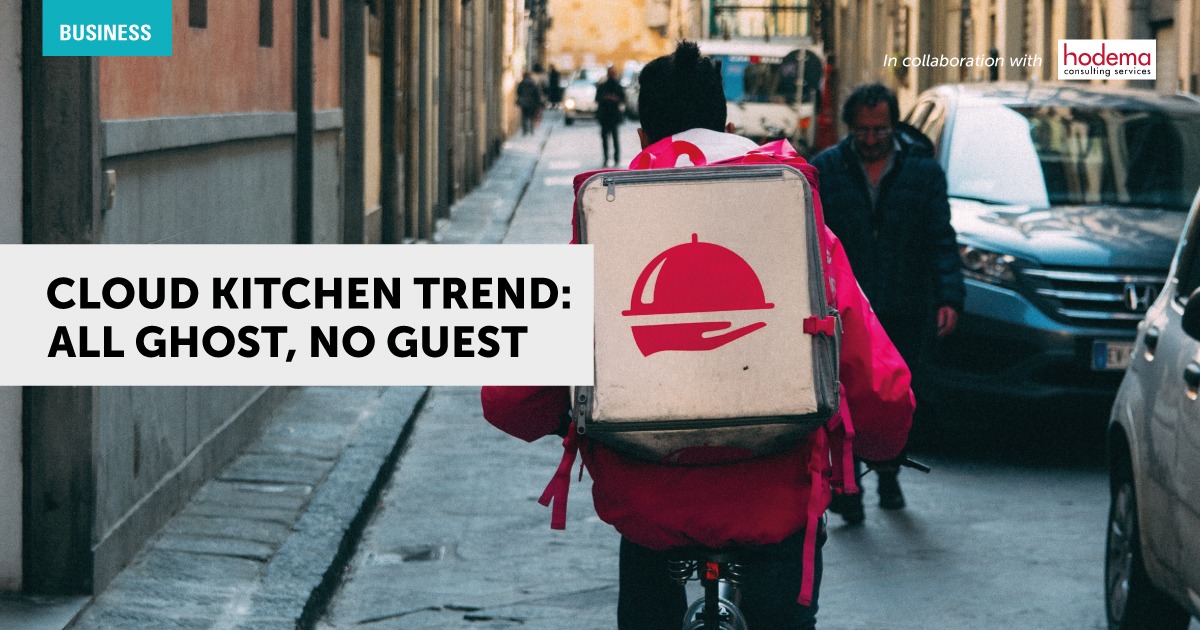As the global pandemic lockdown leaves restaurants, snack shops and bars temporarily out of business, the foodservice industry is racing to find off-premise alternatives to stay afloat and safeguard jobs. Nagi Morkos, managing partner at Hodema consulting services, discusses the latest trend of cloud kitchens.


Also known as dark, ghost, shadow or virtual kitchens, cloud kitchens have gained immense popularity over the past couple of years, and there seems to be no stopping this upward trend.
So what is a cloud kitchen exactly? It is basically a delivery-based no-dine-in restaurant — a kitchen with no storefront. The idea came after observing the growing demand for delivery services, both from independent restaurants and online food ordering and delivery platforms, some of which — like Deliveroo or Uber Eats — have taken over the world. New digital technologies combined with efforts to cut costs have paved the way for the cloud kitchen concept, although most brick and mortar restaurants are also offering delivery and take-away services to improve their margins and ease their overheads.
A cost-cutting business model
Eliminating a dine-in area means no serving staff and no decor expenses. It enables the owner to sidestep real estate costs by shedding the front-of-house and operating from non-prime locations. Significant savings are also made on marketing and operations. This hoard of cash can end up being a lifeline for small, independent outlets that can increase their capacity to cater to the delivery market. And the setup costs are low as well, which means that newbies can try new brands, dishes and concepts without risking it all and changing their minds overnight without the hassle of refurbishing their premises. Also, the audience they deliver their food to is larger than the usual round-the-corner customer. Within the industry, the word has obviously been passed around in no time. The offer has thus multiplied across the globe to match the ever-growing demand. And it seems that online food delivery is what demanding millennials have been asking for all along: a digital interface, a quick and no-fuss process, personalized offers combined with new cuisine trends and tailor-made marketing techniques.
Behind the (multifaceted) scenes
With the concept expanding rapidly, many F&B investors felt its potential and started developing many different types of cloud kitchens.
The original and most straightforward version is the “standalone” model: a single kitchen specialized in one menu for a single brand. It’s basically a restaurant with no physical store. The next one in line is a mix between a cloud kitchen and a takeaway joint. The business model resembles the former, but it has a storefront like the latter. The front window enables clients to see their food being prepared. Here, we’re still talking about a single kitchen for a single brand.
There are more sophisticated versions based on data intelligence, which gives insights on area demographics, demand/supply ratio for delivery and cuisine popularity. In neighborhoods where there’s opportunity to compete with the local dine-in and takeaway offer, large cloud kitchens are opening to cater to the needs of multiple brands. Each of them still positions itself as an individual eatery, but behind the scenes they share a single kitchen to keep operational costs down. Brands can either belong to the same owner or join forces. There’s also the “hub-and-spoke” model, where a central kitchen prepares the food, and then semi-cooked dishes are shipped to final smaller outlets where they are finalized before shipping. Big tech names have chipped in, like former Uber chief Travis Kalanick in CloudKitchens or Google in Kitchen United.
Then there’s the aggregator owned cloud kitchens. These tech-enabled startups turned digital giants, such as Deliveroo Editions, had the idea early on to set up their own structures, which could directly be connected to their online ordering and delivery framework. But their core activity is not cooking, so they decided to provide empty kitchen spaces with basic equipment (gas, drainage and ventilation systems) — also known as “shell” or “Kitchen as a Service” (KaaS) — to restaurant operators, who bring their cooking apparatus, staff, produces and recipes. In short, the restaurant does the cooking and the aggregator does the rest. There are as many tailor-made options as requirements, from fridge space only to kitchen space with built-in equipment and comprehensive processes. The latest addition to the cloud kitchen world is an outsourced business model, where most things are done elsewhere, from orders to the cooking prep and delivery. The chefs just have to add the final touches to the dishes.
Delivering on time
With all the dine-in-related aspects removed, cloud kitchens now focus on what matters most: food quality, packaging and a timely delivery. This latter aspect is key. The main challenge is automating and optimizing the delivery process to get the food to the customer as fast as possible. With that in mind, operators — the ones using shell kitchens run by aggregators excluded — have two delivery alternatives. The classic way is to develop your own delivery system, either through an application or through websites which are connected to in-house or outsourced delivery services. Many chains with multiple outlets have gone down that road. Some of them are using the second option as well: here, we’re talking aggregators again. Deliveroo, Uber Eats, Just Eat or GrubHub gather millions of food outlets, from snacks to high-end restaurants, small local joints to international chains.
The region is no exception
With a local tradition of takeaway and delivery deeply rooted across the Middle East, cloud kitchens have arrived in conquered territory. Their expansion is still uneven within the region though, but in Gulf countries and Lebanon some companies are starting to make big money. American and European “usual suspects” aggregators have already set up their online ordering and delivery services, and local investors are jumping in. Kitopi, founded in Dubai in 2018, operates 30 cloud kitchens across the region, as well as the US and UK. Its portfolio includes PizzaExpress and Operation Falafel among others. Meals are delivered through various aggregators like DoorDash, Uber Eats and Deliveroo. The company has recently taken the plunge by raising USD 60m in new funding to expand its operations worldwide. Food To Go is also in expansion mode, and has already partnered with Karaz from Beirut, Miyabi Sushi, D.O.N. Pizza, Burger Pit and Mambo Pizza. Since 2017 Deliveroo Editions has been operating in the city to enable restaurants to deliver in no time underserved areas. Virtual brands specifically created for cloud kitchens have also been developed, such as Go! Greek and Go! Healthy, conceived by The Virtual Restaurant Company (VRC).
Cloud kitchens already had a bright future ahead of them, and the coronavirus lockdown is accelerating the trend even faster. The main downside, however, is their reliance on aggregators, which leads to concentration risk. Competition is also fierce, with newcomers flooding the market everyday as most brands experience an irregular client flow. Since people have no physical or emotional connection with the restaurant, creating customer loyalty is no easy task. Some kitchens have also been criticized for creating disturbances, questionable working conditions and hygiene standards. But all in all ordering your meal from the cloud is now here to stay.

Nagi Morkos
Managing Partner
Hodema
















